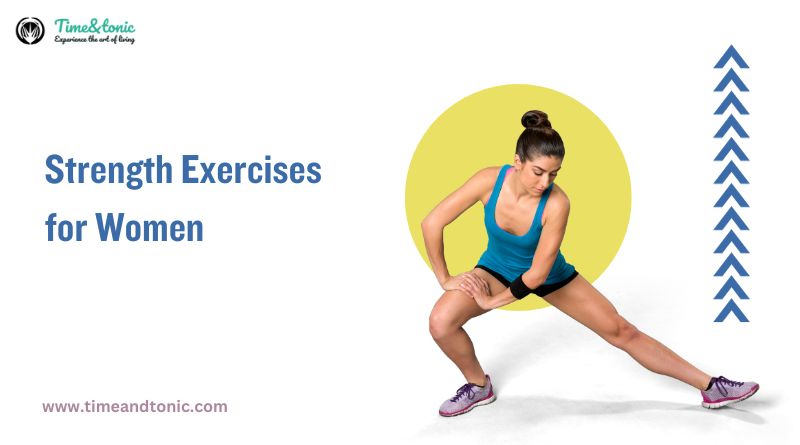Empower Her: Effective Strength Exercises for Women
In the realm of fitness and empowerment, women are rewriting the narrative, embracing their strength, both physically and mentally. The journey toward physical empowerment begins with a foundation built on strength, and for women, this journey is more significant than ever before. Welcome to our comprehensive guide on “Strength Exercises for Women,” a holistic approach to reshaping the way women perceive and engage with their bodies.
Traditionally, strength training has been misunderstood by many women, shrouded in myths that it leads to bulkiness or is too challenging. However, in reality, it is the key to unlocking a world of newfound confidence, resilience, and vitality. In this guide, we will explore the science behind strength training, debunk common misconceptions, and delve deep into a myriad of exercises tailored specifically for women. Whether you are a beginner taking your first steps into the world of weights or an experienced enthusiast seeking to elevate your routine, this guide is your trusted companion.
Join us as we unravel the secrets of strength exercises for women, helping you sculpt not just your muscles but also your mindset. Let’s embark on this empowering journey together, redefining what it means to be strong and resilient as a woman.
Why Strength Training is Crucial for Women
Strength training is not just a fitness trend; it’s a fundamental component of overall health and well-being, especially for women. Here’s why it’s crucial:
Preserving Muscle Mass: As women age, they naturally lose muscle mass, which can lead to reduced strength and a slower metabolism. Strength training helps preserve and build lean muscle, countering this natural decline and ensuring greater mobility and independence as women age.
Boosting Metabolism: Muscles burn more calories at rest than fat does. By increasing muscle mass through strength training, women can boost their metabolism, making it easier to manage weight and maintain a healthy body composition.
Improving Bone Density: Osteoporosis, a condition characterised by weakened bones, is more common in women. Strength training places stress on bones, stimulating them to grow denser and stronger, reducing the risk of fractures and osteoporosis.
Enhancing Mental Health: Exercise, including strength training, triggers the release of endorphins, which reduce stress and anxiety. For women juggling various roles, this can be a powerful way to manage daily stressors and maintain mental well-being.
Reducing the Risk of Chronic Diseases: Regular strength training can lower the risk of chronic conditions such as heart disease, diabetes, and certain cancers. It also improves insulin sensitivity, helping regulate blood sugar levels.
Essential Equipment and Safety Measures for Strength Training
When embarking on a strength training journey, having the right equipment and adhering to safety measures are paramount. Here’s a guide to essential equipment and safety precautions tailored for women:
Essential Equipment
1. Dumbbells: Dumbbells are versatile and ideal for various strength exercises. Opt for a set of different weights to accommodate various exercises and fitness levels.
2. Resistance Bands: These bands provide resistance, enhancing the effectiveness of bodyweight exercises. They are excellent for toning muscles and improving flexibility.
3. Stability Ball: Stability balls engage core muscles and improve balance. They are especially useful for enhancing core strength exercises and can replace a weight bench in many exercises.
4. Kettlebells: Kettlebells offer a unique shape for dynamic exercises, promoting functional strength. They are excellent for full-body workouts, enhancing both strength and cardiovascular fitness.
5. Yoga Mat: A non-slip yoga mat provides a comfortable surface for exercises, ensuring stability during workouts and cushioning joints.
6. Weight Bench: A weight bench is essential for exercises like bench presses and step-ups. Look for an adjustable bench to diversify your workouts.
Safety Measures
1. Warm-Up and Cool Down: Begin each session with a 5-10 minute warm-up like jogging or jumping jacks to increase blood flow to muscles. Cool down with stretching exercises to improve flexibility and reduce muscle soreness.
2. Proper Form and Technique: Correct form is crucial for preventing injuries. Start with lighter weights to master proper technique before progressing to heavier loads. Consider working with a trainer initially to learn correct form.
3. Gradual Progression: Avoid overexertion. Lift heavier and more intensely over time to give your body a chance to adjust. Listen to your body and rest when needed to prevent overtraining.
4. Rest and Recovery: Muscles need time to repair and grow stronger. Aim for at least 48 hours of rest between strength training sessions targeting the same muscle group.
5. Hydration and Nutrition: Stay hydrated before, during, and after your workout. Proper nutrition, including protein for muscle repair, is essential for optimal results.
6. Consultation and Adaptation: If you have pre-existing health conditions or injuries, consult a healthcare provider or a fitness professional. They can help modify exercises to suit your needs, ensuring a safe and effective workout.
Strength Exercises for Women
Strength training for women is not about bulky muscles; it’s about building lean, strong, and toned physiques. Here’s a selection of effective strength exercises tailored specifically for women, targeting different muscle groups:
Upper Body Strength Exercises for Women
A. Push-ups: Mastering the Basics
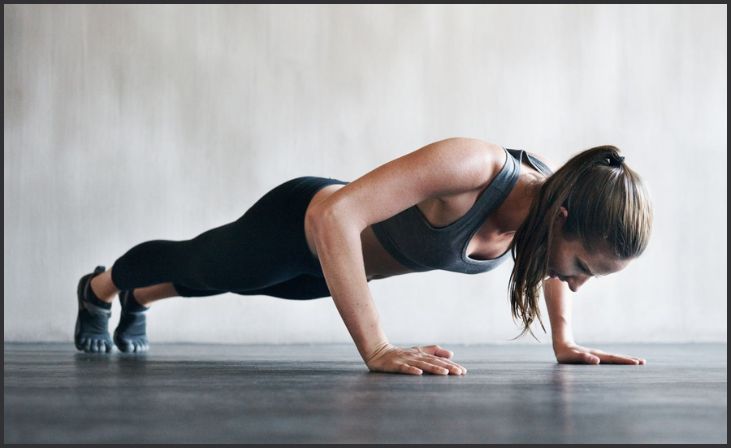
- Start out in a plank position with your hands just wider than shoulder width apart.
- Reduce your height until your chest is almost parallel to the floor.
- Simply push up to bring yourself back to square one.
- Modification: Perform knee push-ups if full push-ups are challenging.
B. Dumbbell Shoulder Press: Sculpting Strong Shoulders
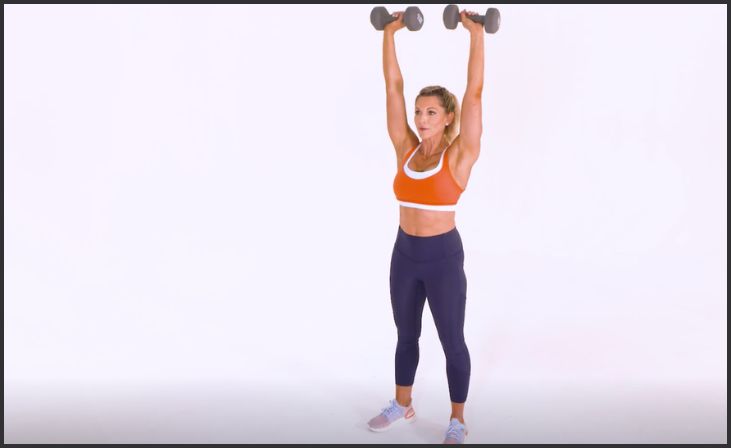
- Dumbbells should be held at shoulder height in each hand.
- Lift the weights up and out with your arms fully extended.
- The dumbbells should now be at shoulder height.
- To keep yourself stable, contract your core.
C. Tricep Dips: Toning the Back of Arms
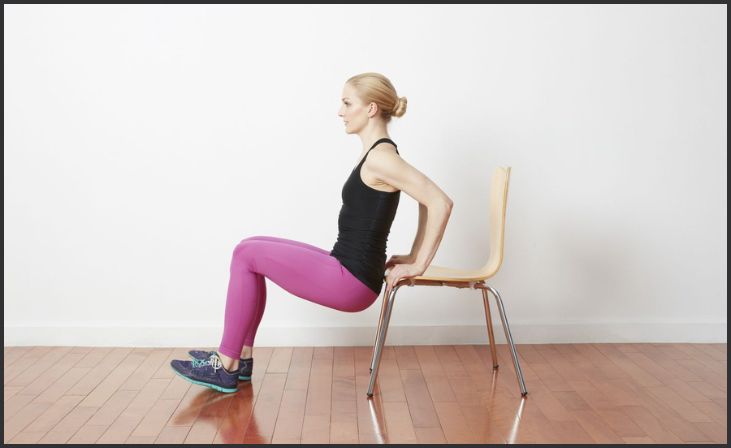
- Sit on the edge of a stable surface (like a chair or bench) with your hands gripping the edge.
- Take a few steps forward while bending your elbows to lower your body.
- Using your triceps, raise yourself back up to the starting position.
- Keep your back close to the surface for effectiveness.
Also read: The Ultimate Guide to Stretches for Runners
Women’s Core Strength Exercises
A. Plank Variations: Building a Solid Core
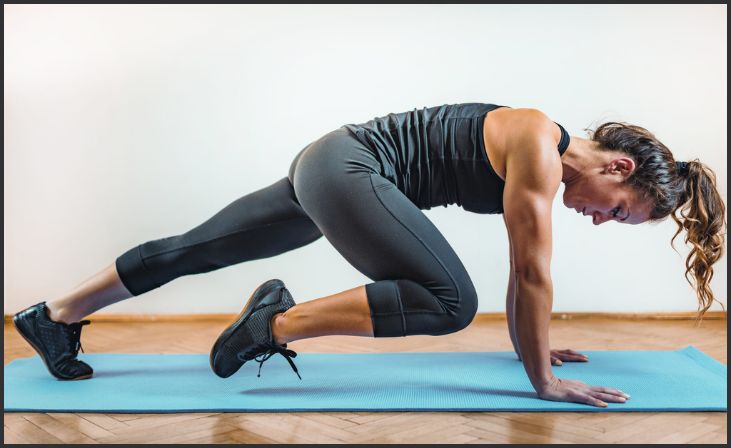
- Standard Plank: Hold a plank position with your body in a straight line from head to heels, engaging your core muscles.
- Side Plank: Rotate to one side, balancing on one arm and the side of your foot.
- Plank Leg Lifts: From a plank position, lift one leg off the ground while maintaining the plank form.
B. Russian Twists: Strengthening Obliques
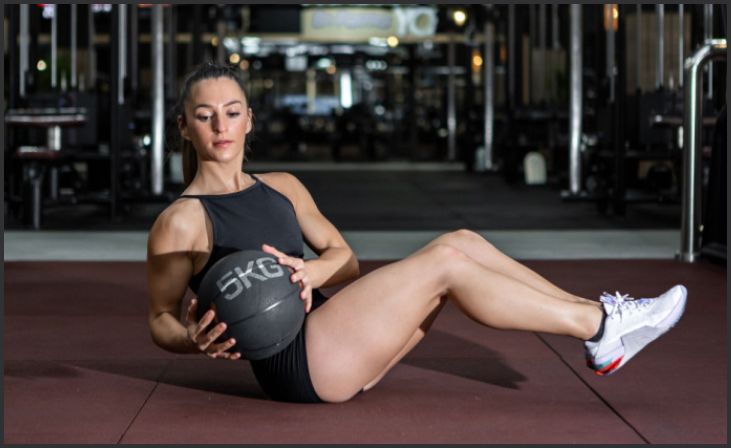
- Kneel on the ground and lean back slightly as you sit.
- With both hands, hold a medicine ball or weight..
- Your weight should be close to the ground next to your hip as you twist your torso to one side.
- Twist to the opposite side and then return to the center.
C. Leg Raises: Developing Lower Abdominal Muscles

- Straighten your legs as you lay flat on your back.
- Keep your legs straight as you raise them up toward the ceiling.
- Without letting them touch the ground, lower them back down.
- During the entire movement, contract your core muscles.
Also Read: Best Free Weight Exercises for a Powerful Physique
Lower Body Strength Exercises for Women
A. Squats: Perfecting the Form for Strong Legs and Glutes

- Place your feet shoulder-width apart as you stand.
- Lower your body as if you were sitting back into a chair, keeping your chest up and knees behind your toes.
- In order to get back to the starting position, drive through your heels.
B. Lunges: Shaping Thighs and Buttocks

- Your back knee should be pointing toward the ground as you lunge forward with one foot.
- Repeat on the opposite side after pushing back to the starting position.
- Ensure your front knee is directly above your ankle during the lunge.
C. Glute Bridges: Activating and Toning the Glute Muscles
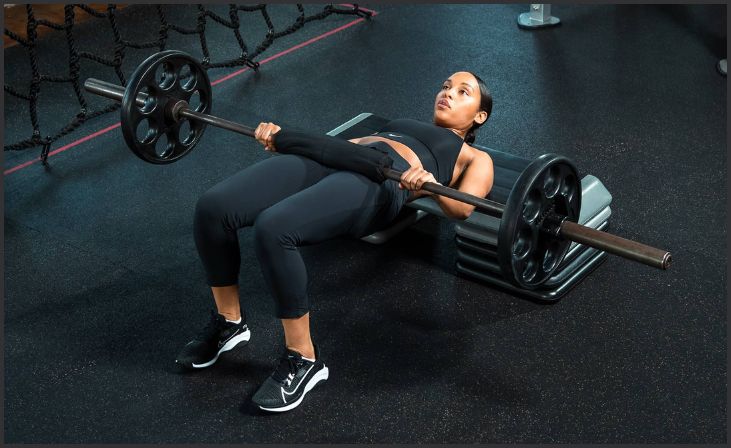
- Flatten your feet and bend your knees to lie on your back.
- Raise your thighs toward the ceiling as you contract your glutes.
- Without touching the floor, bring your hips back up and then raise them once more.
Also Read: The Ultimate Guide to Waist-Sculpting Core Exercises
Advanced Strength Exercises for Women
Once you’ve mastered the basics of strength training, advancing your routine is crucial for continued progress. These advanced strength exercises are tailored for women looking to challenge their bodies and take their fitness to the next level.
Deadlifts
- Standing with a barbell in front of you, your feet should be hip-width apart.
- Bend your knees and hinge at your hips to lower your body and grip the barbell with hands slightly wider than shoulder-width apart.
- Controlled motions are used to return the barbell to the ground.
Pull-Ups
- Grab an overhead bar with your palms facing away from you, hands slightly wider than shoulder-width apart.
- Pull your body up until your chin is over the bar by engaging your core.
- Controlfully reposition your body downward.
- Modification: Use an assisted pull-up machine or resistance bands for support if full pull-ups are challenging.
Kettlebell Swings
- Stand holding a kettlebell in front of you with both hands, slightly wider than shoulder width apart.
- Swing the kettlebell between your legs while bending your knees just a little bit.
- Drive your hips forward forcefully, raising the kettlebell to your shoulders.
- Repeat while controlling the swing back down between your legs.
Bulgarian Split Squats
- Stand facing away from a bench or sturdy surface, about two feet away.
- Put the sole of one foot on the bench behind you while you stretch the other leg out.
- Lower your body into a lunge position, keeping your front knee directly above your ankle.
- To get back to the starting position, drive through your front heel.
Renegade Rows
- Hold a dumbbell in each hand and get into a plank position.
- Row one dumbbell up to your hip while balancing on the other arm.
- Repeat on the opposite side, lowering the dumbbell to the ground.
- Throughout the movement, maintain hip stability and core muscle engagement.
Box Jumps
- Stand in front of a sturdy box or platform with your feet shoulder-width apart.
- Leaping explosively onto the box while bending your knees, you softly land with your knees slightly bent.
- Retract your steps, then leap back up.
- Repeat the motion as you softly land.
Conclusion
In embracing the world of strength exercises for women, women embark on a transformative journey toward empowerment and vitality. With each lift and push, they redefine their limits, sculpting not just their bodies but also their confidence and resilience. Remember, strength is not just about what you can lift; it’s about what you can overcome. As you continue this journey, may your strength be your beacon, guiding you to a life of enduring health and self-assurance. Stay strong, stay empowered.
FAQ
Aim for at least two to three strength training sessions per week, allowing your muscles to rest between sessions for optimal recovery and growth.
Strength training does increase metabolism, which helps with weight loss. It also preserves lean muscle mass, ensuring weight loss comes from fat, not muscle.
Balance is key. Lift weights that challenge you but allow proper form. Mix heavier weights with fewer reps for strength and lighter weights with more reps for endurance.

